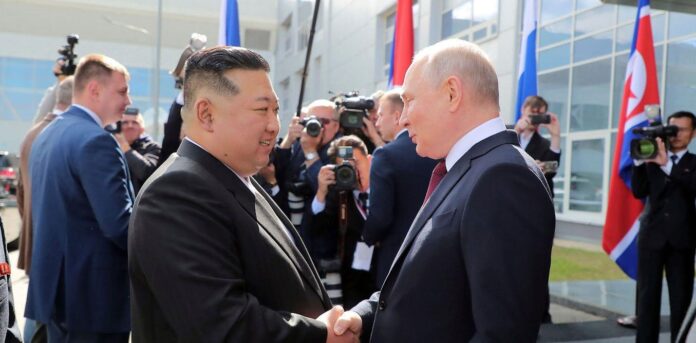Russian and North Korea artillery deal paves the way for dangerous cyberwar alliance
Robert M. Dover, University of Hull
Russia is currently firing some 14 million shells a year in Ukraine. They are only manufacturing 2 million. The Ukrainians, on the other hand, are firing around 2.5 million shells a year, but are also struggling to source them.
A deal between North Korea and Russia for artillery rounds, which the respective leaders have said they are “actively advancing”, is a simple solution to Russia’s problem. But it is a deal that is fraught with dangers for global stability.
The sanctions on Russia since their invasion of Ukraine have limited where they can buy military equipment, including artillery rounds: it has made requests to China, Iran and now North Korea. China has been warm but publicly resisted directly supplying equipment into the battlefield.
Iran has sold Russia drones and a small quantity of shells. North Korea is the first nation to make the move to directly supply a large quantity of ammunition for Russian artillery. Placed within its wider context this deal will likely be written up in history as part of the journey to a wider war.
Both Russian president Vladimir Putin and North Korean leader Kim Jong-Un are reluctant to travel internationally. The meeting with Putin on September 13 is the first time Kim has travelled internationally since the outbreak of COVID in 2020.
He travelled in a heavily armoured train. A face-to-face meeting is a symbolically important event for both men: because of its rarity and because its proximity signals trust.
What Russia needs
Russian ground offensives and their well dug-in defensive lines have been reliant on the extensive use of artillery.
The Russian army has been ineffective at maintaining their supplies of shells, which has increased the pressure on them to buy from the international market. By contrast, the stocks of shells on the Korean peninsula – a legacy of the Korean War (1950-1953), which still remains technically at ceasefire, rather than over – are well maintained by North and South Korea.
Consequently, the US is buying South Korean shells to transfer to Ukraine, and Russia will shortly be receiving North Korean shells. The rates of fire from both sides can, therefore, be maintained while their domestic industries continue to transform to meet the needs of this war.
Russia is not a natural ally of North Korea. In the 1990s, Russia was part of international efforts to restrain North Korea’s development of nuclear technologies.
By instinct, Russia, like China, has a strong preference for stability in its near neighbours, and a nuclear North Korea with the ability to reach the US or Europe would be destabilising. However, the invasion of Ukraine and the need for a large amount of artillery ammunition has created the basis for this pragmatic alliance.
What does Kim want?
North Korea wants to trade its ammunition for cash, for food aid and for advanced military technologies. How much Russia transfers in these categories will be the best guide to how much Russia needs North Korean ammunition.
Regardless of its need, Russia is unlikely to transfer anything beyond improved missiles for North Korea’s nuclear programme: but not hypersonic missiles or miniaturised warheads. Stability in the region remains a strategic concern for Russia, which is in part why US intelligence sought to publicise early rounds of talks to dissuade Russia from carrying on.
Russia’s invasion of Ukraine has strengthened international alignments. Nato has been joined by formerly neutral nation Finland and has an application from Sweden. South Korea and Japan have become much closer, while Russia, China, Iran and North Korea have also moved closer into alignment.
Collaboration on spy satellites, mapping and live intelligence, including communications hacking would also be challenging for the Ukrainians. The connection between a small and nasty war in Eastern Europe with the historical and current tensions in Asia is profoundly dangerous and provides a realistic stepping stone to a wider war.
Cyberwar implications
Both North Korea and Russia are highly capable cyberwar and cyber intelligence nations: they can disrupt or break key infrastructure and steal sensitive government information. North Korea’s Lazarus group of hackers has been identified –– through careful process tracing –– to be responsible for thefts of crypto currency totalling tens of millions of dollars.
Russia’s efforts in online fraud, disinformation and disruption to core infrastructure has become a significant threat to western societies.
Some of the Lazarus Group’s stolen cryptocurrency is stuck because the individual wallets where it is held have been identified. Russia is a potentially valuable collaborator in finding alternative routes to move the “coins” and realise much of the profit.
Mix this with Chinese, Russian and Iranian expertise in influencing operations, hacking and psychological warfare and their collective ability to shape the politics and values of the Euroatlantic area is considerable. The digital flank of this conflict and the ongoing tensions on the Korean peninsula are greatly enhanced by closer collaboration between Russian and North Korea.
An agreement to supply artillery shells is only one aspect of this deal. The wider dangers come from how it will serve to fuel the Ukrainian conflict, and how it brings together Russia, North Korea, China and Iran into a form of alliance. Ultimately, this deal paves the way for more dangerous technology transfers and it connects the Eastern European conflict more directly with tensions in Asia.![]()
Robert M. Dover, Professor of Intelligence and National Security, University of Hull
This article is republished from The Conversation under a Creative Commons license. Read the original article.



